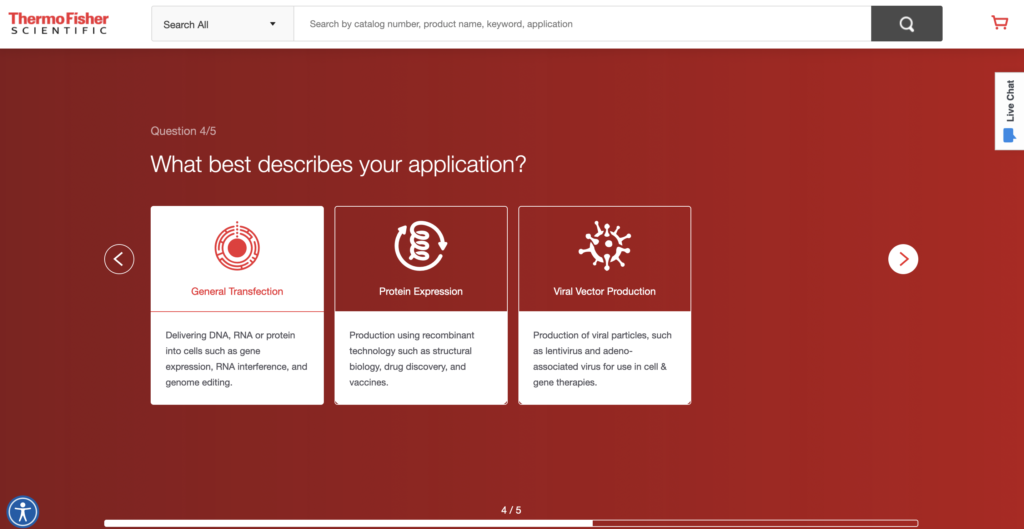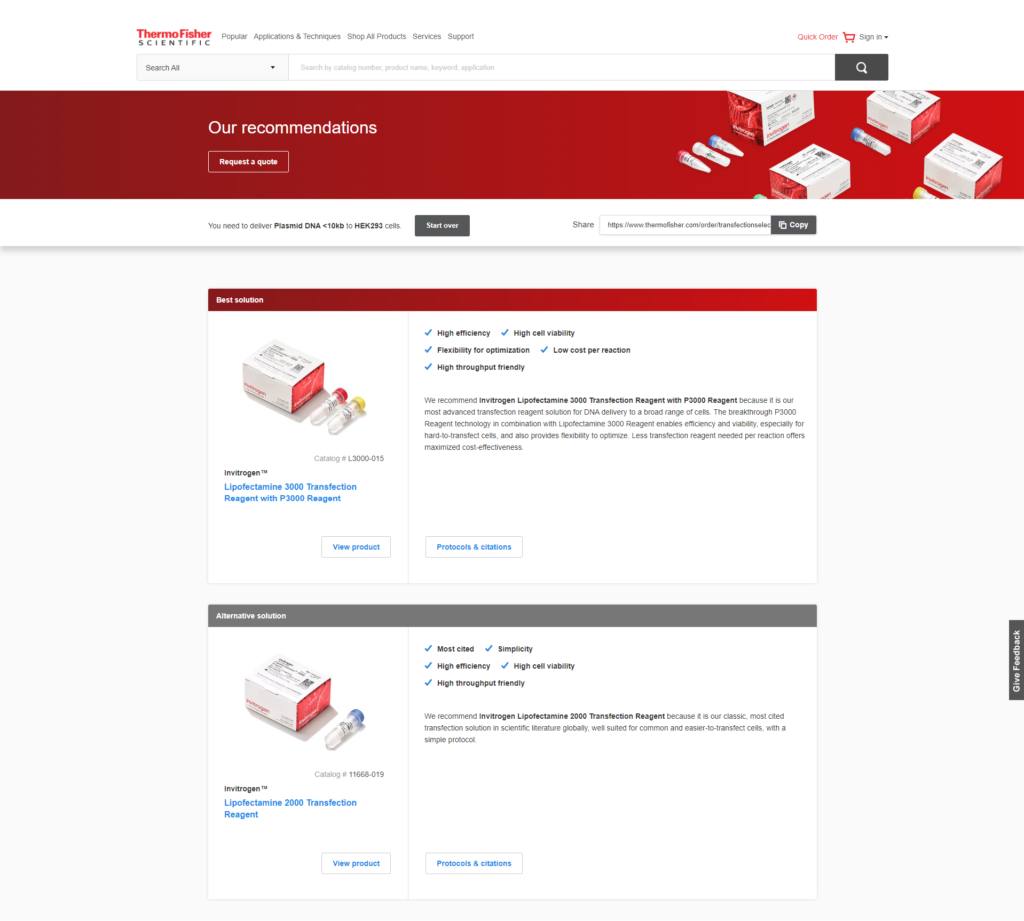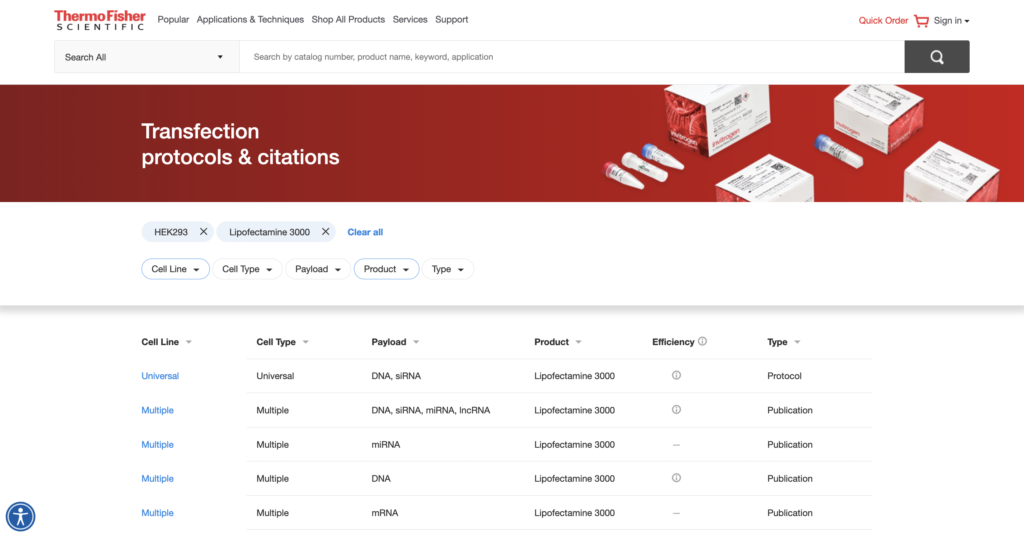
New TransfectionSelect™ Product Selection Tool Takes the Guesswork Out of Improving Transfection Efficiency
Cell transfection is a powerful investigative tool used by many scientists to study gene expression and function across a wide range of applications from cell biology, cancer research, bioproduction of proteins and viruses to developing novel gene therapies to treat diseases. Transfection involves introducing foreign nucleic acids (DNA and RNA) or even proteins into eukaryotic cells. Whether you are new to transfection or it is part of your everyday lab routine, ensuring you have the highest transfection efficiency is critical to experimental success. Defined as the percentage of cells transfected over the total cells, optimizing transfection efficiency can be a tricky endeavor as it is prone to many variable factors, such as cell type, health status, size and type of genetic payload, delivery method–it can be difficult to know where to start to improve your transfection.
A variety of genetic payloads, including plasmid DNA, RNA, proteins and antibodies, may be transfected into target cells through chemical, biological, or physical transfection methods. With regards to target cells, transfection of immortalized cell lines (i.e., CHO, HeLa, HEK293), primary cells and stem cells are often used across different research applications. Regardless of the transfection strategy or payload, the introduced genetic material can either be expressed transiently where it remains in the cell for a limited period and is not integrated, or it may be stably integrated into the host cell’s genome, able to be transmitted during replication.
Due to several variables, there is no single transfection method that can be applied across cell types and transfection efficiencies may vary greatly as a result of the selected experimental parameters. Therefore, to obtain high efficiencies, careful consideration of all applicable factors is required to select the appropriate transfection method. This can sometimes be a prolonged and challenging endeavor. To this end, Thermo Fisher Scientific™ has recently launched a new web-based tool called TransfectionSelect™–a new product and protocol selection tool –designed to help take the guesswork out of optimizing transfection efficiency, regardless of cell type, payload or application.
TransfectionSelect Product Selection Tool
As someone who has had first-hand transfection experience, I was interested to try out the new web-based tool for myself. According to the instructions, I only needed to answer a brief set of questions. Questions can vary from 3-5 questions depending on responses. Based on my inputs, I answered 4 questions about my transfection needs that the algorithm would use to compile a list of recommended transfection products along with a curated collection of protocols and peer-reviewed citations.
To start the process, I first had to choose whether I was looking for information about in vitro or in vivo transfection. As part of my run-through, I selected in vitro transfection. Next, I was prompted by the tool to select the cell type of interest. A drop-down list was available for easy selection and I was impressed by the extensive list available, with >150 types of mammalian, insect, human stem and primary cell types to choose from.

I selected one of the frequently used cell lines, HEK293 cells, and was directed to the next question in the cue, where I was prompted to select my desired genetic payload. I selected the first option available–plasmid DNA <10kb size.

The final question addressed my transfection application, and I was given the choice of general transfection, protein expression or viral vector production.

The TransfectionSelect tool processed my answers and I was provided with recommendations based on my cell type, genetic payload and transfection application. I liked that I was provided with several ranked options along with some quick highlights of key features for each recommendation so that I could decide based on all factors.

For example, the ‘best solution’ recommended for transfecting HEK293 cells with plasmid DNA (<10kb) for in vitro transfection was Lipofectamine 3000 reagent. Each product had clickable links to relevant product information and the curated protocols and citations from ThermoFisher’s extensive online library specific to my requirements.

Overall, I was impressed with the easy-to-use web interface and the TransfectionSelect tool provided a variety of resources to consider for my specific transfection parameters. Designed and backed by ThermoFisher’s extensive in-house transfection expertise, this new online tool represents a rapid and streamlined way for scientists to access relevant transfection products and protocols, whether they are new to transfection, embarking on transfection with a new cell type or seeking ways to improve their existing methodology.
Try the new tool here: https://www.thermofisher.com/order/transfectionselect/#!/